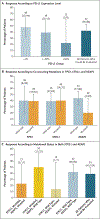Sotorasib for Lung Cancers with KRAS p.G12C Mutation
- PMID: 34096690
- PMCID: PMC9116274
- DOI: 10.1056/NEJMoa2103695
Sotorasib for Lung Cancers with KRAS p.G12C Mutation
Abstract
Background: Sotorasib showed anticancer activity in patients with KRAS p.G12C-mutated advanced solid tumors in a phase 1 study, and particularly promising anticancer activity was observed in a subgroup of patients with non-small-cell lung cancer (NSCLC).
Methods: In a single-group, phase 2 trial, we investigated the activity of sotorasib, administered orally at a dose of 960 mg once daily, in patients with KRAS p.G12C-mutated advanced NSCLC previously treated with standard therapies. The primary end point was objective response (complete or partial response) according to independent central review. Key secondary end points included duration of response, disease control (defined as complete response, partial response, or stable disease), progression-free survival, overall survival, and safety. Exploratory biomarkers were evaluated for their association with response to sotorasib therapy.
Results: Among the 126 enrolled patients, the majority (81.0%) had previously received both platinum-based chemotherapy and inhibitors of programmed death 1 (PD-1) or programmed death ligand 1 (PD-L1). According to central review, 124 patients had measurable disease at baseline and were evaluated for response. An objective response was observed in 46 patients (37.1%; 95% confidence interval [CI], 28.6 to 46.2), including in 4 (3.2%) who had a complete response and in 42 (33.9%) who had a partial response. The median duration of response was 11.1 months (95% CI, 6.9 to could not be evaluated). Disease control occurred in 100 patients (80.6%; 95% CI, 72.6 to 87.2). The median progression-free survival was 6.8 months (95% CI, 5.1 to 8.2), and the median overall survival was 12.5 months (95% CI, 10.0 to could not be evaluated). Treatment-related adverse events occurred in 88 of 126 patients (69.8%), including grade 3 events in 25 patients (19.8%) and a grade 4 event in 1 (0.8%). Responses were observed in subgroups defined according to PD-L1 expression, tumor mutational burden, and co-occurring mutations in STK11, KEAP1, or TP53.
Conclusions: In this phase 2 trial, sotorasib therapy led to a durable clinical benefit without new safety signals in patients with previously treated KRAS p.G12C-mutated NSCLC. (Funded by Amgen and the National Institutes of Health; CodeBreaK100 ClinicalTrials.gov number, NCT03600883.).
Copyright © 2021 Massachusetts Medical Society.
Figures


Comment in
-
Sotorasib effective in KRAS-mutant NSCLC.Nat Rev Clin Oncol. 2021 Aug;18(8):470. doi: 10.1038/s41571-021-00533-w. Nat Rev Clin Oncol. 2021. PMID: 34140669 No abstract available.
-
Finally, Effective Inhibitors of Mutant KRAS.N Engl J Med. 2021 Jun 24;384(25):2447-2449. doi: 10.1056/NEJMe2107884. N Engl J Med. 2021. PMID: 34161711 No abstract available.
-
"New Targets in Non-Small-Cell Lung Cancer"-RET, HER2, and KRAS.Am J Respir Crit Care Med. 2024 Mar 15;209(6):748-750. doi: 10.1164/rccm.202208-1596RR. Am J Respir Crit Care Med. 2024. PMID: 38190703 No abstract available.
References
-
- Siegel RL, Miller KD, Fuchs HE, Jemal A. Cancer statistics, 2021. CA Cancer J Clin 2021; 71:7–33. - PubMed
-
- Black RC, Khurshid H. NSCLC: an update of driver mutations, their role in pathogenesis and clinical significance. R I Med J (2013) 2015; 98: 25–8. - PubMed
-
- Gandhi L, Rodríguez-Abreu D, Gadgeel S, et al. Pembrolizumab plus chemotherapy in metastatic non–small-cell lung cancer. N Engl J Med 2018;378: 2078–92. - PubMed
-
- Mok TSK, Wu Y-L, Kudaba I, et al. Pembrolizumab versus chemotherapy for previously untreated, PD-L1-expressing, locally advanced or metastatic non-small-cell lung cancer (KEYNOTE-042): a randomised, open-label, controlled, phase 3 trial. Lancet 2019; 393:1819–30. - PubMed
Publication types
MeSH terms
Substances
Associated data
Grants and funding
LinkOut - more resources
Full Text Sources
Other Literature Sources
Medical
Research Materials
Miscellaneous
